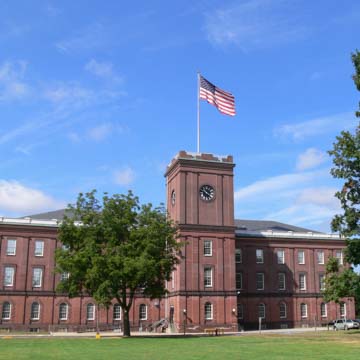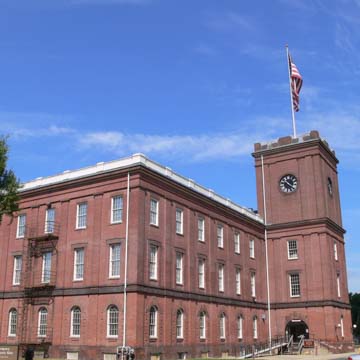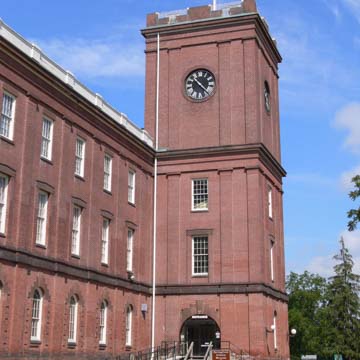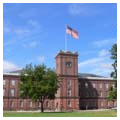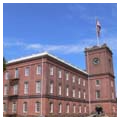You are here
Main Arsenal, Springfield Armory
The Main Arsenal of the Springfield Armory is a potent symbol of the power of the United States military. Completed in 1851, the imposing red brick, three-story Main Arsenal occupies one end of the Springfield Armory’s Green, a central, open space surrounded by Armory buildings. This central landscape of the Armory sits on a hill just east of downtown Springfield. From the American Revolution through to the Vietnam War, the Springfield Armory manufactured the majority of the U.S. military’s small arms, primarily rifles. The Main Arsenal operated as one of dozens of federal buildings in Springfield that were dedicated to the production and storage of the firearms that served as critical tools for over a century and a half of U.S. military engagements.
On a local level, the Springfield Armory plays an important role in the history of Springfield, evidenced by the inclusion of the Main Arsenal on the city’s official seal. During the middle third of the nineteenth century, Springfield industrialized rapidly just as the Armory developed new methods and technology to greatly increase the efficiency and productivity of industrial manufacturing. The availability of manufacturing jobs at the Armory attracted Irish, British, and French Canadian immigrants to Springfield. Though the Armory closed in 1968, its original campus remains largely extant and serves as the home to both the Springfield Technical Community College and the Springfield Armory National Historic Site, which has transformed the Main Arsenal into a museum interpreting the history of firearm manufacturing at the Springfield Armory.
As tensions with England escalated in 1776, Colonel Henry Knox and General George Washington chose the colonial town of Springfield as the prime location for producing munitions and store arms. A seventeenth-century fur-trading outpost and agricultural settlement on the Connecticut River, Springfield served as the nexus of several inland trading routes during the colonial period. Additionally, smaller streams feeding into the Connecticut provided ample waterpower, and the town had a stable population of laborers. These factors combined to render Springfield an excellent strategic location for an arsenal. The new facility, located on a hilltop east of the center of town, stored weapons and manufactured paper shot-powder cartridges during the American Revolution, and, in 1794, the young U.S. Congress officially established Springfield Armory as a national armory to produce and store muskets in order to end the U.S. military’s reliance on foreign-made weapons.
Springfield Armory and its environs grew considerably during the first half of the nineteenth century. Successive military engagements with England, Native American tribes, and Mexico increased both the size of the United States’s military forces and the demand for new weapons. Supplemental structures proliferated on the hilltop campus in order to accommodate the new industrial scale of manufacturing. During the early nineteenth century, workers at the Springfield Armory introduced technological developments that had repercussions throughout the world. Most important, in 1825, the Springfield Armory began assembling guns using interchangeable parts made with machines that required little skill to operate. Earlier, skilled workers handcrafted muskets and firearms individually from start to finish and thus no two guns were exactly the same. The new procedures at Springfield precipitated the rise of assembly-line production, which revolutionized manufacturing in myriad industries. Additionally, the Springfield Armory attracted private firearms manufacturers to the city, such as Smith and Wesson, which was founded in 1852. Private firearms producers drew on the city’s base of skilled laborers who had a working knowledge of gun manufacturing. These private corporations did not necessarily compete with the federal armory, but often worked collaboratively in order to wean the country off of foreign-made arms.
In 1841, Major James Ripley assumed position of superintendent at the Armory and, during his 13-year tenure, instituted a large-scale building program. To represent the growing size and status of the U.S. military, the buildings at Springfield were designed to impress. Ripley significantly built up the Armory’s campus, and the Main Arsenal became the centerpiece of the Green. With its simple ornamentation, the Main Arsenal expresses an authoritarian and utilitarian nature through simple, bold forms and massing. Built of brick with brownstone trim, the monumental, symmetrical Main Arsenal was meant to symbolize the primacy, order, and longevity of the country’s armed forces. On the front facade a square, crenellated central tower rises two stories over the building’s main rectangular block and marks the main entrance. The tower has clocks on three facades, alluding to the tight regulation of time at the combined military and industrial complex. The building’s first floor has arched windows with rusticated surrounds and brick pilasters rise to a wide brownstone belt course between the first and second floors. The second and third floors have windows with simple brownstone trim that are flanked by two-story brick pilasters. The building’s rear facade has a central, projecting pavilion with a clock in the pediment. Work on the Main Arsenal began in 1847 and, after its completion in 1851, the building served as a repository for weapons produced in other buildings in the Armory’s campus. The interior program afforded ample storage space on the first floor, with additional room for offices and safeguarding firearms. Within the central tower, a distinctive spiral wooden staircase that has no visible supports provides access to each floor.
Like the Armory’s built environment in general during Ripley’s time, the Main Arsenal’s fortress-like air served both didactic and practical ends. The building declared the power of the U.S. military, while also operating as a single functioning element within an industrial landscape. Furthermore, while the Main Arsenal bears similarities to the many town and city armories scattered throughout the country, its immense size sets it apart from these local institutions and signals it as a federal building.
The Main Arsenal continued to store manufactured firearms into the twentieth century, but also became an important part of the city’s identity. The building, with its distinctive tower, not only graces the city’s seal, but also became a popular destination for residents and tourists during the nineteenth century. As part of a nationwide reduction in military bases and the privatization of the defense industry, the federal government closed Springfield Armory in 1968, an act that the city’s residents intensely resisted. The 1966 National Historic Preservation Act, though, required the federal government to assure the preservation of the site’s historic structures, which had been declared a National Historic Landmark in 1964.
Over the next several years, the National Park Service worked with local and state officials to develop a master plan for the site’s post-industrial future. Eventually, in 1978, the National Park Service officially established the Springfield Armory National Historic Site. The Park Service co-manages the grounds with the Springfield Technical Community College, which began utilizing the abandoned buildings in the early 1970s. The Main Arsenal now houses administrative offices and an interpretive museum that narrates the site’s history and displays a large collection of firearms.
References
Crosbie, Allison. Cultural Landscape Report for Armory Square – Springfield National Historic Site. Boston, MA: Olmsted Center for Landscape Preservation, National Park Service, 2010.
Rettig, Polly, “Springfield Armory,” Hampden, Massachusetts. National Register of Historic Places Registration Form, 1974. National Park Service, U.S. Department of the Interior, Washington, D.C.
Writing Credits
If SAH Archipedia has been useful to you, please consider supporting it.
SAH Archipedia tells the story of the United States through its buildings, landscapes, and cities. This freely available resource empowers the public with authoritative knowledge that deepens their understanding and appreciation of the built environment. But the Society of Architectural Historians, which created SAH Archipedia with University of Virginia Press, needs your support to maintain the high-caliber research, writing, photography, cartography, editing, design, and programming that make SAH Archipedia a trusted online resource available to all who value the history of place, heritage tourism, and learning.

